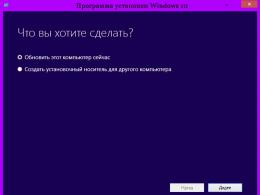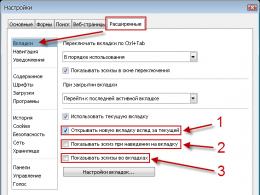Windows 10 is not updating. Installing the update using the Windows Update Minitool utility
Windows 10 updates may be different: 10041, 9860, 1511, 10586 - more likely to appear in the future.
At the same time, the Windows 10 update itself can be considered from two positions - updating from older versions (seven or eight) and directly obtaining new versions of the ten itself.
Some computer or laptop owners have problems in both cases.
After the release of version 10586, it became available for everyone. Why?
Microsoft is partly to blame, although it’s probably not their fault, it’s just how they wanted it. They have removed the link from their website to the free download and subsequent manual installation of update 10586 as an ISO image.
Now they send him out in “waves”, in other words, not everyone at once - “happiness” will have to wait. If you are standing in a “queue”, it means you have to wait.
The first reason why Windows 10 update 10586 does not arrive
If you have the “Updates from multiple places” option enabled, then you need to disable it - it will not allow you to get the new version (that’s what Microsoft decided).
To do this, open “update and security”, select the “Advanced options” section and disable this feature in the update center. Then you can start searching for available Windows 10 updates.
Update to Windows 10 version 1511 or 10586 manually if it doesn’t work automatically
If the automatic options do not work, you can download version 1511 yourself. There are 2 ways to do this trick.
The first is to use the Media Creation Tool utility (you can download it for free from the Microsoft website), launch it and click on the “Update Now” button.
The second is to download the Windows 10 ISO file and create a bootable USB flash drive or disk.
Then you can perform a clean installation through the BIOS or overlay the old version without leaving the system by clicking on the setup.exe file
Reason three why there is no upgrade to Windows 10 from 7
If you currently have the current operating system seven, then Service Pack 1 must be installed on it, otherwise the update will not come.
Also, seven or eight must be completely legal and activated
One more thing. Users on the Home version can only upgrade to Windows 10 Home, while those on Pro can upgrade to dozens of Pros.
Reason four why there is no update to Windows 10 – changes at Microsoft
Microsoft has changed its decision on how the latest version of Windows 10 10586 can be installed.
If some time ago users were advised to download the ISO image and update manually, now all those who have not yet updated to ten will have to perform a clean installation of the first version of RTM and, after they have done this using Windows Update, install all updates , released from July until now.
This strange decision will certainly hinder migration to Windows 10, but sooner or later, the top ten will reach all compatible computers and laptops, free or for a fee - the operating system from Microsoft has more advantages than those offered by OS X or GNU / Linux .
Moreover, interest in Windows 10 is increasing. By the way, anyone who doesn’t upgrade for free will have to fork out $120 for the basic Home version or $200 for the professional version.
Free updates are available only in new versions starting from version seven. Therefore, if you are still using Vista, then nothing will work for you. Good luck.
Windows 10 differs in many aspects from previous Microsoft operating systems, including the location of system files, as well as the presence and access to special features and functionality of the OS. The Update Center has also undergone certain changes, which will be discussed below. However, setting up Windows 10 System Update itself has not become more complicated, but on the contrary, it has become simpler and more convenient.
Windows 10 Update- a program with which the operating system is updated to more current versions, and also downloads updates for related programs. Without it, the operating system on your computer will quickly lose its relevance and will not have many additional features that appear over time.
Location
Previously, this program could be accessed through the Control Panel, but now no user finds it there. Now the Update Center can be opened through the menu " Start" In it you need to go to the section “ Options", from there to the section " Update and Security" In this submenu you can easily find this program and update your system with it.
How to check for updates
To make sure that your system has updates, you need to click the button Checking for updates, which will show all the updates found and suggest their installation. In addition, there are not many properties that can be adjusted in the basic settings. You can configure a wider range of parameters if you click on the item “ Extra options" Not every build of Windows 10 supports this method. It is available in Pro, Education and Enterprise versions.
How to set up Update Center
The automatic operating system update process is configurable and can be disabled in several ways. The methods below allow you to quickly do this without having to install additional utilities.
Using the built-in Services program

Using the Registry Editor
- Open the Registry Editor using the key combination Win + R.
- Type regedit command
- There, go to the folder " Auto Update", located along the path " Hkey_Local_Machine» → « Software» → « Microsoft» → « Windows» → « CurrentVersion» → « WindowsUpdate».
- In the menu that appears, double-click on the item “ AUOption" After that, set it to 1. This means that Update Center will stop checking for new versions of Windows programs. If you want to enable updates again, just change the value to 0.
It is possible that such a parameter will not exist, then you need to write it down yourself. Just right-click on a section of the field and select to create a separate parameter with the DWORD type. Name it the same as indicated here.

In the Advanced Options menu
Go to the Update Center menu following the guide above. Select " Extra options" and go to the window " Notify about reboot" There select " Defer updates».
It is worth saying that with this method of disabling, updates will still be installed.
You can enable automatic updates from here.
Possible problems
Sometimes it may happen that a previously working update center stops functioning for unknown reasons. Below are the most common problems with this program and solutions if suddenly the update service does not work.
Solving problems using the Troubleshooting Manager in Windows 10
Modern Windows operating systems have a built-in way to deal with application failures and problems. You can also use it to deal with problems with Update Center not working.
- Go to the menu " Start».
- In the search line, write “ Troubleshooting».
- Double click on the icon that appears. A window will open with the menu “ system and safety" There, at the very bottom, click on the item “ Troubleshooting».
- In the menu that appears, click " Additionally", check the box " Accept corrections automatically" and confirm running as administrator.
- After that, click Next and wait. After some time, the repair process will complete and “ Update centre» will resume work.
Error "Service Registration is Missing or Corrupt"
This problem occurs if a proxy server is registered on your computer without permission to update. There are two ways out of this situation: do not use a proxy for updates, or set the permission in the system itself.
Restarting Update in Windows 10
In the operation of this program, situations sometimes arise when the error is not corrected by the Troubleshooting Center, as well as by other methods.

Thus, the most effective method of solving the problem is to reset the Update Center system and restore it to default.
To do this you need to do the following:

Upon completion of this procedure, the Update Center will be reinstalled along with all related services. This way, the system will stop crashing and start updating.

In general, this is all that can be said about Update Center in Windows 10. Its work, of course, is somewhat different from what it was before, however, it still performs the same functions as before the new OS from Microsoft. In addition, in the tenth version of Windows it is located in a different place, which changes the procedure for setting it up and debugging it.
Video on the topic
The article will tell you why Windows 10 updates are not installed and how to get rid of the problem that arose during the operating system update process.
Microsoft said that there are no plans to release Windows 11 in the near future. Instead, changes will be made to the “ten”, released in the form of updates. As a result, the operating system over several years of development will be very different from Windows 10 released in the summer of 2015 in all respects: performance, functionality, appearance, capabilities.
Moreover, the user will not be able to refuse to receive innovations in the system. It can only briefly delay the download of updates that do not relate to OS security. And the option is available only in the professional and corporate versions; owners of the tens home edition will not even be able to delay downloading updates.
Only a registry editor, a tool for editing group policies, or third-party utilities that perform the corresponding manipulations with registry entries in one click will help you completely avoid installing updates in the “ten”.
Solution
Let's get straight to the topic of conversation.
The software giant's forum contains brief instructions for solving the problem: close the Update Center, wait at least 15 minutes, and call the Windows 10 update tool again.

Checking for new updates.

After exiting the center, try restarting your computer, sometimes it helps.
To avoid manual checks for updates, go to “Advanced settings”.

Set the method for receiving updates to “Automatic (recommended)”.

2. Activate the service responsible for updates
Advanced users or people using pirated builds of "tens" encounter problems when updating the OS due to the fact that the Windows 10 update service is inactive. This is done to avoid problems with activation and to disable constant downloads and installation of incomprehensible operating system updates.
1. To enable the service, call the command interpreter using the Win+R combination, enter services.msc in the text form and execute the command with the “Enter” key or the “OK” button.

2. In the window with a list of services, we find the “Windows Update” or “Windows Update” service in some “tens” assemblies.

3. Using the context menu, go to the “Properties” of the service.

4. In the “Startup Type” section, set the value to “Automatic” or “Manual” if you want to perform the update once.
5. Click on the “Run” button and close the windows, saving the adjustments made.

3. We use the capabilities of the tool for diagnosing and fixing system problems
1. Through the “Control Panel” or the search bar, launch the “Troubleshoot Windows 10 Update” tool.

3. Give the application administrator privileges.

Once the scan is complete, a window will appear showing the results of the troubleshooter.

4. Close the window.
After this, it is advisable to restart the computer.
4. Let's use the problem-finding tool downloaded from the Microsoft resource
- We are looking for a tool for detecting and troubleshooting problems with the “dozens” on the Microsoft website and downloading it.
- Launch the utility and click “Next” after selecting the problem.

As a result of the application's operation, detected problems will be corrected.
5. Other problems
Among the other factors that cause problems with “tens” updates are:
- lack of free space on the system partition;
- occupied by cache update files loaded with errors;
- blocking Internet access by firewall.
You constantly receive a message that updates have arrived. But as soon as you click update, errors occur and updates are not installed. If you are facing a similar Windows 10 update issue, then read on. I'll tell you what you need to do to update your Windows 10 operating system.
Hello. I recently encountered a problem. My antivirus program constantly writes me messages that there is a new version of my operating system and I need to update. But when I go to Settings, all updates show an error. That, they say, it was not possible to install the updates.
Why isn't Windows 10 updating?
The thing is that Windows 10 is very sensitive to the Firewall and does not want to install updates without it. In order to install updates you need to enable it.
Turn on the firewall
Go to Control Panel and see if Windows Firewall is enabled. Most likely it will be turned off, try turning it on. If that doesn't work, then do the following.
- Open the search, it’s a magnifying glass, it’s located near the “Start” button. You can also launch the search by pressing the key combination “Windows + Q”.
- In the search, write the word “Services” and press “Enter”. A list of services will open.
- Find "Windows Firewall".
- Right-click on this item.
- From the context menu, select Properties.
- Next, find the line “Startup type”, set the value to “Automatic”.
- Now, click "Apply" and "OK".
- Next, without removing the selection from “Windows Firewall”, find the inscription “Run” at the top left, click on it.
That's it, you have enabled the firewall, now try updating the system. Go to “All Settings”, “Update and Security”, and try running updates there.
After installing the updates, you can disable the "Firewall" if you wish. Follow these instructions, but instead of selecting “Automatic” in “Startup Type,” select “Disabled.” Or, you can turn off the firewall in Control Panel.






